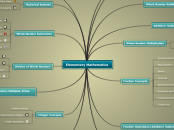Elementary Mathematics
Patterns and Sequences
Sequences and Types
Sets
Venn Diagrams
Whole Number Addition
Addition Whole Number Operation Properties
Addition Algorithms
Addition Tables
Addition/ Subtraction Fact Family
Definitions
Fact Family Steps
Whole Number Multiplication
Three Major Models
Multiplication Properties
Fraction Concepts
Developmental Constructs
Misconceptions
Models
Language
Equivalent Fractions
Estimation with Fractions
Comparing Fractions
Fraction Kits
Fraction Operations (Addition/ Subtraction)
Whole Number Contexts
Strategies
Mixed Number Concepts
Mixed Number Addition/ Subtraction
Decimals
Decimal Concepts
Decimal Operations
Problem Solving
Plan
Strategies
Numerical Systems
Bases and Place Value
Types of Numeration Systems
Whole Number Subtraction
Subtraction Models
Subtraction Properties
Subtraction Algorithms
Subtraction with Manipulatives
Subtraction with Different Bases
Division of Whole Numbers
Two Major Models
Division Properties
Fact Families for multiplication and division
Strategies and Alternate Algorithms
Divisibility Rules, Factors, Multiples, Prime and Composite
Definitions
Divisbility Tests
Factor Rainbows
Integer Concepts
Problem Solving
Understanding Integers
Integer Operations
Fraction Operations (Division/ Multiplication)
Multiplication and Division Contexts
Apply contexts to Word Problems
Fraction Multiplication with Paper Folding
Area Model
Fraction Division
